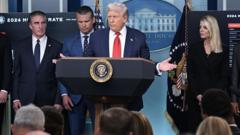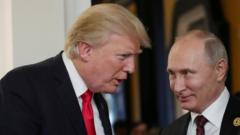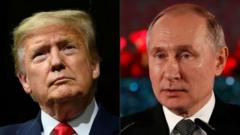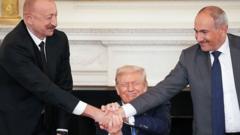As Trump leverages tariffs in efforts to influence foreign policy, the efficacy and consequences of such measures remain unclear.
Trump's Tariffs: Economic Pressure or Diplomatic Gambit?

Trump's Tariffs: Economic Pressure or Diplomatic Gambit?
A look into how President Trump's tariff strategy impacts international relations and domestic markets.
As President Trump intensifies his campaign to resolve the Ukraine conflict, he has turned to tariffs as a potential diplomatic tool aimed at persuading Russia to cease its military actions. Traditionally, tariffs are not the primary means associated with conflict resolution, yet Mr. Trump has employed this strategy to exert pressure on nations. Recently, he imposed an unprecedented 50 percent tariff on imports from Brazil and India, claiming these moves were necessary to deter cooperation with Russia amid its ongoing aggression in Ukraine.
The alarming rise in tariffs represents a tactic designed to position America’s market power against opposition, with Mr. Trump using trade as leverage in diplomatic discussions. Notably, the president had set a deadline for Russia to agree to a cease-fire, yet chose not to follow through with additional tariffs on Russian allies, indicating a complex interplay between economic sanctions and diplomatic diplomacy. The proposed escalation of tariffs on Thailand and Cambodia amid their border tensions illustrates Trump's willingness to challenge multiple countries simultaneously.
Historically, economic strategies, particularly sanctions, have been a common method for influencing foreign governments. However, tariffs represent a more nuanced approach, aimed not at direct financial penalties, but at hampering the competitiveness of specific goods in the U.S. market. Scholars like Emma Ashford comment on the growing trend of these coercive economic measures, highlighting how Trump's strategy aligns more with sanctions than traditional trade policy.
The application of tariffs as a diplomatic tool has yielded mixed results thus far. Notably, countries such as India have shown resilience against U.S. tariff threats, continuing to procure Russian oil despite rising costs due to these taxes. Experts suggest that while tariffs can inflict economic pain, their impact is limited by the fact that the U.S. represents a small fraction of global import markets, making these measures less effective than outright sanctions.
Moreover, the repercussions of these tariffs extend beyond foreign relations; they heighten tensions between nations and lead to increased costs for American consumers, as businesses typically pass on the added tax burden. Analysts argue there is a pressing need to reassess the long-term ramifications of such tariffs on U.S. diplomacy and the wider global economy.
Previous administrations have attempted to utilize tariffs for political leverage, but Trump’s aggressive approach marks a notable shift. His actions have led to a strategic stalemate in cases like the evolving relationship with Colombia, where his tariff threats prompted swift negotiations, albeit with resistance from local leadership. Meanwhile, the increasingly polarized relationship with Brazil over domestic political fallout regarding the previous administrations further complicates international trade dynamics.
In conclusion, as Trump's administration continues its unique application of tariffs to pursue foreign policy goals, the question lingers: Are these economic pressures a viable path to achieving diplomatic resolutions, or will they remain largely performative in nature?
The alarming rise in tariffs represents a tactic designed to position America’s market power against opposition, with Mr. Trump using trade as leverage in diplomatic discussions. Notably, the president had set a deadline for Russia to agree to a cease-fire, yet chose not to follow through with additional tariffs on Russian allies, indicating a complex interplay between economic sanctions and diplomatic diplomacy. The proposed escalation of tariffs on Thailand and Cambodia amid their border tensions illustrates Trump's willingness to challenge multiple countries simultaneously.
Historically, economic strategies, particularly sanctions, have been a common method for influencing foreign governments. However, tariffs represent a more nuanced approach, aimed not at direct financial penalties, but at hampering the competitiveness of specific goods in the U.S. market. Scholars like Emma Ashford comment on the growing trend of these coercive economic measures, highlighting how Trump's strategy aligns more with sanctions than traditional trade policy.
The application of tariffs as a diplomatic tool has yielded mixed results thus far. Notably, countries such as India have shown resilience against U.S. tariff threats, continuing to procure Russian oil despite rising costs due to these taxes. Experts suggest that while tariffs can inflict economic pain, their impact is limited by the fact that the U.S. represents a small fraction of global import markets, making these measures less effective than outright sanctions.
Moreover, the repercussions of these tariffs extend beyond foreign relations; they heighten tensions between nations and lead to increased costs for American consumers, as businesses typically pass on the added tax burden. Analysts argue there is a pressing need to reassess the long-term ramifications of such tariffs on U.S. diplomacy and the wider global economy.
Previous administrations have attempted to utilize tariffs for political leverage, but Trump’s aggressive approach marks a notable shift. His actions have led to a strategic stalemate in cases like the evolving relationship with Colombia, where his tariff threats prompted swift negotiations, albeit with resistance from local leadership. Meanwhile, the increasingly polarized relationship with Brazil over domestic political fallout regarding the previous administrations further complicates international trade dynamics.
In conclusion, as Trump's administration continues its unique application of tariffs to pursue foreign policy goals, the question lingers: Are these economic pressures a viable path to achieving diplomatic resolutions, or will they remain largely performative in nature?



















